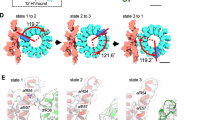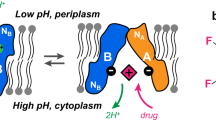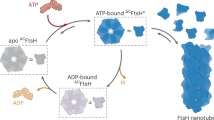Abstract
The crystal structure of the c-ring from the proton-coupled F1Fo ATP synthase from Spirulina platensis is shown at 2.1-Å resolution. The ring includes 15 membrane-embedded c subunits forming an hourglass-shaped assembly. The structure demonstrates that proton translocation across the membrane entails protonation of a conserved glutamate located near the membrane center in the c subunit outer helix. The proton is locked in this site by a precise hydrogen bond network reminiscent of that in Na+-dependent ATP synthases. However, the structure suggests that the different coordination chemistry of the bound proton and the smaller curvature of the outer helix drastically enhance the selectivity of the H+ site against other cations, including H3O+. We propose a model for proton translocation whereby the c subunits remain in this proton-locked state when facing the membrane lipid. Proton exchange would occur in a more hydrophilic and electrostatically distinct environment upon contact with the a subunit interface.
This is a preview of subscription content, access via your institution
Access options
Subscribe to this journal
Receive 12 print issues and online access
$259.00 per year
only $21.58 per issue
Buy this article
- Purchase on SpringerLink
- Instant access to full article PDF
Prices may be subject to local taxes which are calculated during checkout





Similar content being viewed by others
References
Boyer, P.D. The binding change mechanism for ATP synthase—some probabilities and possibilities. Biochim. Biophys. Acta 1140, 215–250 (1993).
Abrahams, J.P., Leslie, A.G.W., Lutter, R. & Walker, J.E. Structure at 2.8 Å resolution of F1-ATPase from bovine heart mitochondria. Nature 370, 621–628 (1994).
Noji, H., Yasuda, R., Yoshida, M. & Kinosita, K. Jr. Direct observation of the rotation of F1-ATPase. Nature 386, 299–302 (1997).
Junge, W., Sielaff, H. & Engelbrecht, S. Torque generation and elastic power transmission in the rotary FoF1-ATPase. Nature 459, 364–370 (2009).
Stock, D., Leslie, A.G.W. & Walker, J.E. Molecular architecture of the rotary motor in ATP synthase. Science 286, 1700–1705 (1999).
Pogoryelov, D. et al. The c15 ring of the Spirulina platensis F-ATP synthase: F1/Fo symmetry mismatch is not obligatory. EMBO Rep. 6, 1040–1044 (2005).
Meier, T., Polzer, P., Diederichs, K., Welte, W. & Dimroth, P. Structure of the rotor ring of F-Type Na+-ATPase from Ilyobacter tartaricus. Science 308, 659–662 (2005).
Meier, T. et al. Complete ion-coordination structure in the rotor ring of Na+-dependent F-ATP synthases. J. Mol. Biol. 391, 498–507 (2009).
Lightowlers, R.N., Howitt, S.M., Hatch, L., Gibson, F. & Cox, G.B. The proton pore in the Escherichia coli FoF1-ATPase: a requirement for arginine at position 210 of the a-subunit. Biochim. Biophys. Acta 894, 399–406 (1987).
Cain, B.D. & Simoni, R.D. Proton translocation by the F1FoATPase of Escherichia coli. Mutagenic analysis of the a subunit. J. Biol. Chem. 264, 3292–3300 (1989).
Eya, S., Maeda, M. & Futai, M. Role of the carboxyl terminal region of H+-ATPase (FoF1) a subunit from Escherichia coli. Arch. Biochem. Biophys. 284, 71–77 (1991).
Ferguson, S.A., Keis, S. & Cook, G.M. Biochemical and molecular characterization of a Na+-translocating F1Fo-ATPase from the thermoalkaliphilic bacterium Clostridium paradoxum. J. Bacteriol. 188, 5045–5054 (2006).
Laubinger, W. & Dimroth, P. Characterization of the Na+-stimulated ATPase of Propionigenium modestum as an enzyme of the F1Fo type. Eur. J. Biochem. 168, 475–480 (1987).
Neumann, S., Matthey, U., Kaim, G. & Dimroth, P. Purification and properties of the F1Fo ATPase of Ilyobacter tartaricus, a sodium ion pump. J. Bacteriol. 180, 3312–3316 (1998).
Reidlinger, J. & Müller, V. Purification of ATP synthase from Acetobacterium woodii and identification as a Na+-translocating F1Fo-type enzyme. Eur. J. Biochem. 223, 275–283 (1994).
Vollmar, M., Schlieper, D., Winn, M., Büchner, C. & Groth, G. Structure of the c14 rotor ring of the proton translocating chloroplast ATP synthase. J. Biol. Chem. 284, 18228–18235 (2009).
Girvin, M.E., Rastogi, V.K., Abildgaard, F., Markley, J.L. & Fillingame, R.H. Solution structure of the transmembrane H+-transporting subunit c of the F1Fo ATP synthase. Biochemistry 37, 8817–8824 (1998).
Bakels, R.H., van Walraven, H.S., Krab, K., Scholts, M.J. & Kraayenhof, R. On the activation mechanism of the H+-ATP synthase and unusual thermodynamic properties in the alkalophilic cyanobacterium Spirulina platensis. Eur. J. Biochem. 213, 957–964 (1993).
Varco-Merth, B., Fromme, R., Wang, M. & Fromme, P. Crystallization of the c14-rotor of the chloroplast ATP synthase reveals that it contains pigments. Biochim. Biophys. Acta 1777, 605–612 (2008).
Pogoryelov, D. et al. Probing the rotor subunit interface of the ATP synthase from Ilyobacter tartaricus. FEBS J. 275, 4850–4862 (2008).
Gibbons, C., Montgomery, M.G., Leslie, A.G. & Walker, J.E. The structure of the central stalk in bovine F1-ATPase at 2.4 Å resolution. Nat. Struct. Biol. 7, 1055–1061 (2000).
Rodgers, A.J. & Wilce, M.C. Structure of the γ-ε complex of ATP synthase. Nat. Struct. Biol. 7, 1051–1054 (2000).
Guskov, A. et al. Cyanobacterial photosystem II at 2.9-Å resolution and the role of quinones, lipids, channels and chloride. Nat. Struct. Mol. Biol. 16, 334–342 (2009).
Vonck, J. et al. Molecular architecture of the undecameric rotor of a bacterial Na+-ATP synthase. J. Mol. Biol. 321, 307–316 (2002).
Meier, T., Matthey, U., Henzen, F., Dimroth, P. & Müller, D.J. The central plug in the reconstituted undecameric c cylinder of a bacterial ATP synthase consists of phospholipids. FEBS Lett. 505, 353–356 (2001).
Murata, T., Yamato, I., Kakinuma, Y., Leslie, A.G. & Walker, J.E. Structure of the rotor of the V-type Na+-ATPase from Enterococcus hirae. Science 308, 654–659 (2005).
Meier, T. et al. Evidence for structural integrity in the undecameric c-rings isolated from sodium ATP synthases. J. Mol. Biol. 325, 389–397 (2003).
Boyer, P.D. Bioenergetic coupling to protonmotive force: should we be considering hydronium ion coordination and not group protonation? Trends Biochem. Sci. 13, 5–7 (1988).
von Ballmoos, C. & Dimroth, P. Two distinct proton binding sites in the ATP synthase family. Biochemistry 46, 11800–11809 (2007).
Chen, M.F., Wang, J.D. & Su, T.M. Concentration gradient effects of sodium and lithium ions and deuterium isotope effects on the activities of H+-ATP synthase from chloroplasts. Biophys. J. 96, 2479–2489 (2009).
Kaim, G., Wehrle, F., Gerike, U. & Dimroth, P. Molecular basis for the coupling ion selectivity of F1Fo ATP synthases: probing the liganding groups for Na+ and Li+ in the c subunit of the ATP synthase from Propionigenium modestum. Biochemistry 36, 9185–9194 (1997).
von Ballmoos, C. Alternative proton binding mode in ATP synthases. J. Bioenerg. Biomembr. 39, 441–445 (2007).
Murata, T. et al. Crystal structure of rotor ring with DCCD of the V- ATPase from Enterococcus hirae. doi:10.2210/pdb2db4/pdb (5 December 2006).
Pogoryelov, D. et al. Sodium dependency of the photosynthetic electron transport in the alkaliphilic cyanobacterium Arthrospira platensis. J. Bioenerg. Biomembr. 35, 427–437 (2003).
Valiyaveetil, F.I. & Fillingame, R.H. On the role of Arg-210 and Glu-219 of subunit a in proton translocation by the Escherichia coli FoF1-ATP synthase. J. Biol. Chem. 272, 32635–32641 (1997).
Wehrle, F., Kaim, G. & Dimroth, P. Molecular mechanism of the ATP synthase's Fo motor probed by mutational analyses of subunit a. J. Mol. Biol. 322, 369–381 (2002).
Steed, P.R. & Fillingame, R.H. Subunit a facilitates aqueous access to a membrane-embedded region of subunit c in Escherichia coli F1Fo ATP synthase. J. Biol. Chem. 283, 12365–12372 (2008).
Feniouk, B.A. et al. The of ATP synthase: ohmic conductance (10 fS), and absence of voltage gating. Biophys. J. 86, 4094–4109 (2004).
Moore, K.J. & Fillingame, R.H. Structural interactions between transmembrane helices 4 and 5 of subunit a and the subunit c ring of Escherichia coli ATP synthase. J. Biol. Chem. 283, 31726–31735 (2008).
Steed, P.R. & Fillingame, R.H. Aqueous accessibility to the transmembrane regions of subunit c of the Escherichia coli F1Fo ATP synthase. J. Biol. Chem. 284, 23243–23250 (2009).
von Ballmoos, C. et al. Membrane topography of the coupling ion binding site in Na+-translocating F1Fo ATP synthase. J. Biol. Chem. 277, 3504–3510 (2002).
Fillingame, R.H., Angevine, C.M. & Dmitriev, O.Y. Mechanics of coupling proton movements to c-ring rotation in ATP synthase. FEBS Lett. 555, 29–34 (2003).
Greie, J.C., Heitkamp, T. & Altendorf, K. The transmembrane domain of subunit b of the Escherichia coli F1Fo ATP synthase is sufficient for H+-translocating activity together with subunits a and c. Eur. J. Biochem. 271, 3036–3042 (2004).
Diederichs, K. & Karplus, P.A. Improved R-factors for diffraction data analysis in macromolecular crystallography. Nat. Struct. Biol. 4, 269–275 (1997).
Kabsch, W. Automatic processing of rotation diffraction data from crystals of initially unknown symmetry and cell constants. J. Appl. Crystallogr. 26, 795–800 (1993).
McCoy, A.J. Solving structures of protein complexes by molecular replacement with Phaser. Acta Crystallogr. D Biol. Crystallogr. 63, 32–41 (2007).
Terwilliger, T. SOLVE and RESOLVE: automated structure solution, density modification and model building. J. Synchrotron Radiat. 11, 49–52 (2004).
Emsley, P. & Cowtan, K. Coot: model-building tools for molecular graphics. Acta Crystallogr. D Biol. Crystallogr. 60, 2126–2132 (2004).
Zwart, P.H. et al. Automated structure solution with the PHENIX suite. Methods Mol. Biol. 426, 419–435 (2008).
Acknowledgements
We thank W. Kühlbrandt for support and for critically reading the manuscript and K. Diederichs and A. Terwisscha van Scheltinga for useful discussions and help. The staff of the Swiss Light Source (SLS, PXII) and the European Synchrotron Radiation Facility (ESRF) are acknowledged for their support. We also thank A. Royant (L'Institut de Biologie Structurale (ISB), Grenoble) for help with single-crystal spectroscopy and J. Langer for help with the ESI-MS measurements. This work was supported in parts by the Cluster of Excellence “Macromolecular Complexes” at the Goethe University, Frankfurt (Deutsche Forschungsgemeinschaft (DFG) Project EXC 115) and DFG Collaborative Research Center 807.
Author information
Authors and Affiliations
Contributions
D.P. performed the experiments; D.P. and Ö.Y. analyzed the crystallographic data; T.M. and D.P. designed and T.M. directed the research project; D.P., Ö.Y., J.-D.F.G. and T.M. analyzed and interpreted the structure, developed the conceptual model and wrote the paper.
Corresponding author
Rights and permissions
About this article
Cite this article
Pogoryelov, D., Yildiz, Ö., Faraldo-Gómez, J. et al. High-resolution structure of the rotor ring of a proton-dependent ATP synthase. Nat Struct Mol Biol 16, 1068–1073 (2009). https://doi.org/10.1038/nsmb.1678
Received:
Accepted:
Published:
Issue date:
DOI: https://doi.org/10.1038/nsmb.1678
This article is cited by
-
Molecular dynamics simulation of proton-transfer coupled rotations in ATP synthase FO motor
Scientific Reports (2020)
-
Correlation between the numbers of rotation steps in the ATPase and proton-conducting domains of F- and V-ATPases
Biophysical Reviews (2020)
-
Engineered Protein Model of the ATP synthase H+- Channel Shows No Salt Bridge at the Rotor-Stator Interface
Scientific Reports (2018)
-
Mycobacterial Membrane Proteins QcrB and AtpE: Roles in Energetics, Antibiotic Targets, and Associated Mechanisms of Resistance
The Journal of Membrane Biology (2018)
-
Direct assignment of 13C solid-state NMR signals of TFoF1 ATP synthase subunit c-ring in lipid membranes and its implication for the ring structure
Journal of Biomolecular NMR (2018)



